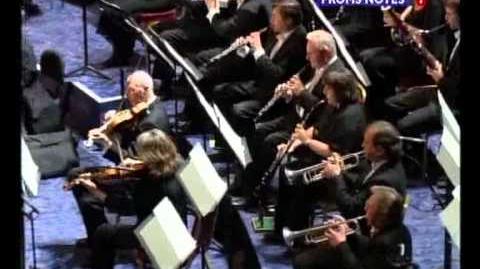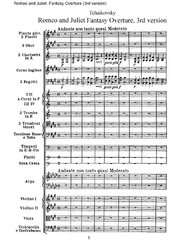
Tchaikovsky Romeo & Juliet Gergiev · London Symphony Orchestra · BBC Proms 2007

Introduction[]
Regarded as the most prominent Russian composer of the 19th century, Piotr Il'yich Tchaikovsky (1840-1893) successfully conjoined Russian nationalism with the musical styles of the Romantic. Tchaikovsky was extremely prolific in his works, writing for several genres including symphonies, operas, ballets, concertos, vocal works, and many more. Using influences from all over Europle, including aspects of Italian opera, French ballet, and German song, Tchaikovsky's works were greatly received by the public. Tchaikovsky was known for his beautifully crafted melodies and passionate lyricism, often building up to a heightened climax in his music. Among the several genres he wrote for, Tchaikovsky used his creativity to compose programmatic concert pieces. In particular, his Fantasy-Overture entitled Romeo and Juliet (1870-1880) was written in a similiar form as a symphonic poem, depicting the tragic love story written by William Shakespeare.
Analysis[]
In 1869, Russian composer Mily Balakirev encouraged Tchaikovsky to set music to Shakespeare's famous play. By 1870, the first version of this orchestral work was complete. The single movement work was written in sonata form and simply consisted of an introduction followed by two themes. After receiving criticism for his initial attempt, Tchaikovsky subsequently revised the work two more times, finally completing his masterpiece in 1880. The symphonic poem begins with a hymn-like chorale of clarinets and bassoons. The strings and woodwinds soon follow, entering with serene chords as well as an underlying theme of foreboding. Following the calm introduction, Tchaikovsky then introduces the two main themes. The first theme is violent and fierce, depicting the warring fued between the Capulets and the Montagues. Instead of developing the theme, Tchaikovsky repeats chaotic figures in order to increase the musical intensity. The first theme then melts into the famous soaring love theme played by the English horn. As the piece reaches the point of recapitulation, the two themes begin to intertwine creating a musical conflict. As the two themes continue to fight one another the piece reaches a passionate climax, representing the tragic death of Romeo and Juliet.
Comparisons []
Tchaikovsky drew influences from many literary sources and even based works off of specific novels. For example, he based his opera Eugene Onegin (1879) on the story by author Aleksander Pushkin. Tchaikovsky infuses Russian folk melodies and Russian style singing in this opera as a way of paying tribute to his Russian heritage. Tchaikovsky was unique in the fact that he was able to successfully combine Western influences with nationalistic elements.
Observations[]
Compared to many of his contemporaries, Tchaikovsky did not have the opportunity for intensive musical study. Because of that, his compositional style lacked sophistication in development and form. However, it is interesting that his works and melodies are some of the most popular and well-known even to this day. Tchaikovsky relied on his raw emotion and passion to create beautiful melodies. Because of that, his works were able to evoke deep emotions and speak to the soul.
Sources[]
Grout, Donald Jay. A History of Western Music. New York: Norton. 1960. Print
Roland, John W. "Tchaikovsky, Pytor Il'yich 2. Study of Music." Grove Music Online . Oxford University Press, n.d. Web. 28 Apr. 2014.
"Tchaikovsky: Romeo & Juliet/Gergiev-London Symphony Orchestra." Youtube Video. Posted by Josep489. Uploaded on June 29, 2011. Accessed on 28 April 2014. https://www.youtube.com/watch?v=Cxj8vSS2ELU